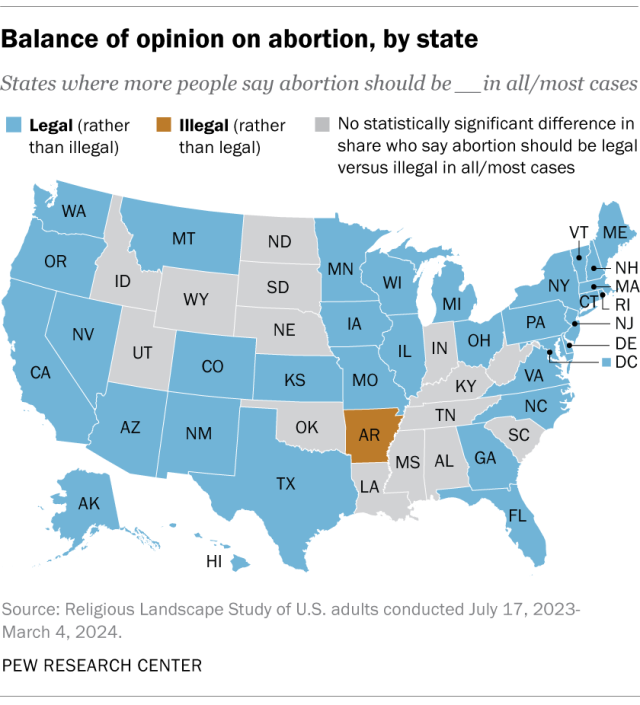Nearly three years have passed since a 2022 Supreme Court decision overturned the constitutional right to an abortion. The ruling gave states new discretion to restrict or ban abortion.
Today, public opinion on whether abortion should be legal or illegal varies considerably from state to state, according to a recent Pew Research Center survey. That survey, the 2023-24 Religious Landscape Study, was large enough to break out results in all 50 states and the District of Columbia, although the margins of error for the state-level estimates are much larger than for the survey’s national estimates.

In 34 states and D.C., more people say abortion generally should be legal than say it generally should be illegal. For example, in the District of Columbia, 81% of adults say abortion should be legal in all or most cases. Support for legal abortion also stands at about 75% or higher in several New England states, including Vermont, Massachusetts, Rhode Island, New Hampshire and Connecticut.
Meanwhile, people in Arkansas are more likely to say abortion should generally be illegal (57%) rather than legal (41%). Arkansas is the only state where the balance of public opinion is against abortion by a statistically significant margin.
In 15 states, the shares saying abortion should be legal and saying it should be illegal are not significantly different once the margins of sampling error in each state are taken into account. (In the chart below, the blue and orange bars show the confidence intervals around each estimate. The 15 states where the differences are not statistically significant have overlapping confidence intervals.)
For example:
- In states like Nebraska and Utah, attitudes are split almost down the middle.
- In Wyoming, Kentucky and Louisiana, 54% say abortion should be legal while 45% say it should be illegal. But these differences are not statistically significant.
- Similarly, 55% of South Dakotans say abortion generally should be illegal. But this share is not significantly higher than the 43% who say it generally should be legal, once the sizable margins of error around these state-level estimates are taken into account.
The survey question asked about people’s views on abortion – whether abortion should be “legal in all cases,” “legal in most cases,” “illegal in most cases” or “illegal in all cases.”
It’s worth noting that the survey did not ask people who think abortion should be legal or illegal “in most cases” about which cases they had in mind. The question was designed to measure attitudes toward abortion broadly (and not toward any specific law).
For more on the views of U.S. adults on this topic, refer to “Public Opinion on Abortion.”
Related: Understanding error bars in charts


